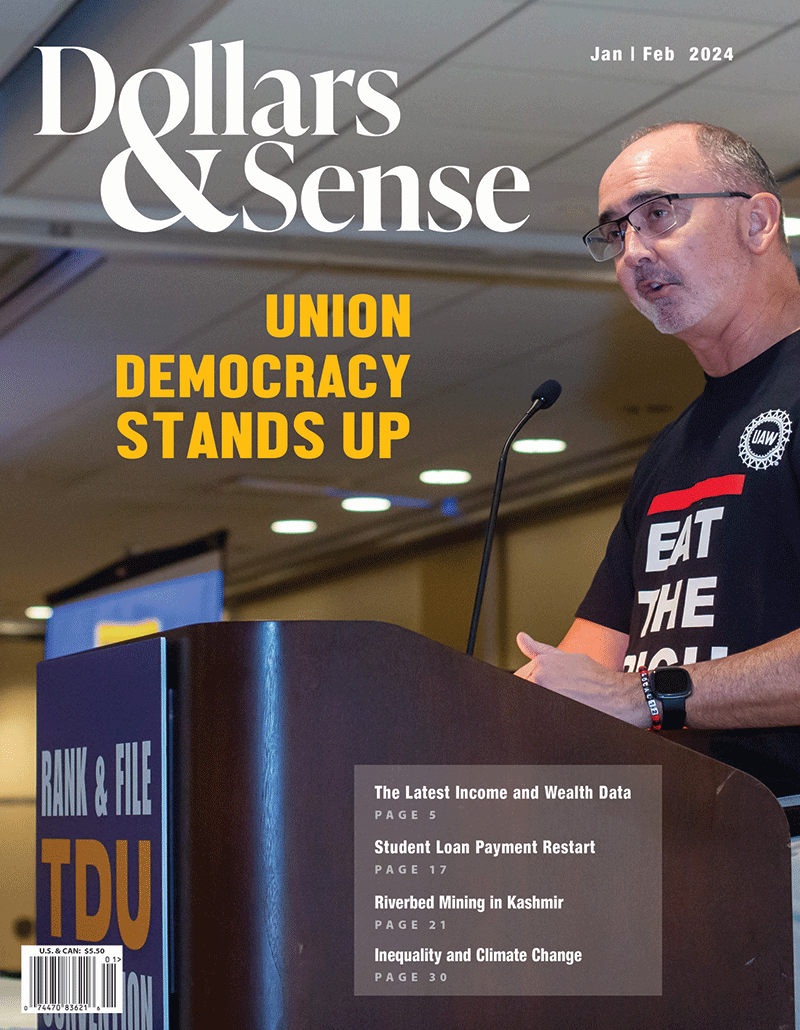This article is from Dollars & Sense: Real World Economics, available at http://www.dollarsandsense.org

This article is from the
January/February 2024 issue.
Subscribe Now
at a 30% discount.

Inequality and Climate Change
A couple of relatively obvious facts:
One: It’s no secret—rich people and large corporations have a disproportionate share of political power.
Two: Rich people and many large corporations contribute disproportionately to climate change. Moreover, rich people have greater abilities than most other people to protect themselves from the negative impacts of climate change.
Taken together, these two facts tell us a lot about why there is considerable opposition—or, if not opposition, foot-dragging—among our governing bodies to take strong and rapid actions toward stopping climate change. This is the case in the United States (on which I will concentrate) but in most other countries as well.
Political Power
It is hardly necessary to support the observation of the disproportionate political power of the rich. But let me give one local illustration. Recently, in Cambridge, Mass., where I live, the city government enacted legislation that would require large commercial buildings (the city’s principal emitters of greenhouse gases) to become “net zero” by dates in the not-too-distant future. The legislation was a step forward, but less strong than it could have been and not as strong as some members of the city council were advocating.
In the preparation of this legislation, the elected city council instructed the city government staff writing the legislation to consult with “stakeholders.” And what groups were defined as “stakeholders”? Owners and developers of large buildings along with Harvard University and the Massachusetts Institute of Technology (MIT), groups that would most directly bear the costs of the legislation. And who were not considered “stakeholders” and not included in the consultations? The residents of the city and all the individuals beyond the city who would reap the benefits of the legislation. Yet the advocates of the less-strong legislation could defend their position by saying that the “stakeholders” were consulted.
The political power of the rich gets much more attention on the national level. Most obvious is that the major contributors to the campaigns of congressional and presidential candidates are wealthy individuals and large corporations. Along with electoral contributions, of course, comes continued access to elected officials—by the contributors and their lobbyists.
These same wealthy people and firms play a large role in affecting ideas, through influence in the schools and by research and publications they support. The broad point was made by the then-CEO of the New York Times Company, Russ Lewis, writing in 2002:
[The press] has an intricate relationship with big business. Today’s news media are themselves frequently a part of large, often global corporations dependent on advertising revenue that, increasingly, comes from other large corporations...It is both impractical and unrealistic to expect news media companies, including newspaper firms, to retreat from their positions as increasingly large, diversified business enterprises. To do so would not only undermine their financial strength; it would also deprive them and their staffs of the resources needed to perform their increasingly difficult and demanding roles.
And then there is the widely propagated idea—not a total fiction, but wildly exaggerated—that if the government does not do what large corporations want, those firms will reduce investment, harming the economic growth and general well-being.
Naming Names
In 2021, five companies supplied the fossil fuels that accounted for almost 30% of the CO2 emissions in the United States:
- Marathon Petroleum (petroleum refining, natural gas extraction), 399 million metric tons of C02, 8.5% of the year’s greenhouse gas emissions.
- Phillips 66 (petroleum refining, natural gas extraction), 272 million tons of CO2, 5.8% of the year’s greenhouse gas emissions
- Valero Energy (petroleum refining and wholesaling, ethyl alcohol manufacturing), 261 million tons of CO2, 5.6% of the year’s greenhouse gas emissions.
- Exxon Mobil (petroleum refining, natural gas extraction, crude petroleum extraction), 246 million tons of CO2, 5.3% of the year’s greenhouse gas emissions.
- Peabody Energy (coal mining), 188 million tons of CO2, 4.0% of the year’s greenhouse gas emissions.
Source: Political Economy Research Institute, “Greenhouse 100 Suppliers Index” (2023 Report, Based on 2021 Data) (peri.umass.edu).
The Rich as Polluters
If I may, let me use another local example, not from my town but from the nearby area. Hanscom Field is an airport just northwest of Boston, sitting close to many wealthy suburbs. On its web page, Hanscom Field is described as “the popular choice for business executives who want easy access to Eastern Massachusetts [and] is home to private and corporate aircraft of all sizes.” It, like Boston’s Logan International Airport, is managed by the Massachusetts Port Authority (MassPort), an “independent public agency.” MassPort has recently proposed extending the field by 49 acres for 27 new hangars. These hangars would accommodate between 55 and 81 additional planes based there, and, presumably, would significantly increase traffic in and out of Hanscom.
This proposal for expansion has given rise to considerable public opposition, focusing on the environmental impact of the anticipated increase in flights by small private jets, “the popular choice for business executives,” according to a page on Hanscom Field at the website of XOJET Aviation, a private jet broker. According to an October 2023 report from the Institute of Policy Studies, private jets pollute 10 to 20 times more per passenger than their commercial counterparts. Following the operation of the 20 most active planes at Hanscom, the report determined that on average they generated 500 tons per year in carbon emissions in recent years. The average Massachusetts citizen is responsible for eight tons per year. (Moreover, as the report points out, the destinations of a significant share of the flights are often resort spots—that is, seemingly more for personal pleasure than for business needs.)
It remains to be seen whether the convenience of business executives will outweigh the public opposition to the MassPort proposal. The required environmental study may have an impact, and the opponents have appealed to Governor Maura Healey to halt the project. Yet the very existence of the proposal and its continuing pursuit by MassPort illustrate the power of wealthy individuals and large firms.
Wealthy people’s generation of greenhouse gas emissions, however, does not come only from lots of flights in high-emission private jets—though that’s not a trivial part of their contribution to global warming. Overall, the richer people are the more goods they buy, the more electricity they use, the more meat they eat, the more they drive, and the bigger the houses they live in. But the carbon footprint of the rich is not only a result of their consumption practices, but also the generation of the high incomes of the rich, through which a high amount of greenhouse gas emissions is generated.
Using consumption as a guide, an International Energy Association analysis determined that the highest-income 10% of people in the United States create on average 56.5 tons of CO2 emissions per person per year. The lowest-income 10% generate only 3.5 tons per person per year. Indeed, with U.S. society divided into 10 equal-size groups, top to bottom in terms of income, each group going down produces less emissions than the group above it.
Similar results were found in a recent study published in the journal PLOS Climate. The study examined responsibility for greenhouse gas emissions in the United States by the sources from which people at different income levels obtained their income. Using various methods of estimation, they found that in 2019 the highest income 10% of the population was responsible for between 43.0% and 32.3% of emissions (with the top one-tenth of 1% responsible for between 7.7% and 4.7%), whereas the 50% of the population with the lowest incomes was responsible for between 13.9% and 33.8% of emissions. (See the sidebar for a list of the companies that are the top CO2 emitters in the United States.)
And which income groups bear the burden of pollution and climate change? There is no measure of this burden by income groups, but the evidence has been usefully summarized by two U.S. government organizations. In its “Fourth National Climate Assessment” of 2019, the U.S. Global Change Research Program succinctly summed up the situation with the statement: “People who are already vulnerable, including lower-income and other marginalized communities, have lower capacity to prepare for and cope with extreme weather and climate-related events and are expected to experience greater impacts.”
A 2021 study by the U.S. Environmental Protection Agency examined social vulnerability and climate change. Among its findings:
Black and African American individuals are found to be most disproportionately at risk, relative to non-Black and non-African American individuals. With global warming of 2°C, Black and African American individuals are 40% more likely than non-Black and non-African American individuals to currently live in areas with the highest projected increases in premature mortality from extreme temperatures, and 34% more likely to currently live in areas with the highest projected increases in childhood asthma diagnoses. Hispanic and Latino individuals are also found to be significantly more likely than non-Hispanic and non-Latino individuals to currently live in areas where impacts are projected to be highest.
Halting Climate Change
The political power of the rich, combined with the disproportionate causes and impacts of climate change, are of central importance in understanding the difficulties of halting climate change. However, there are certainly other factors involved.
Although the benefits of effective actions to curtail climate change are much greater than the costs of those actions, the costs are immediate and fairly clear while most of the benefits are in the future and somewhat uncertain. It is not easy to gain support for a program of costs now when the benefits will occur sometime down the road. Moreover, there is the question of who will pay the costs.
Also, there are technical problems in proposals to avert major climate change. Some of the issues that seemed to be major problems a few years ago—in particular, the costs of solar and wind energy generation—have been greatly reduced, but others remain. For example, energy storage problems on the needed scale remain a lurking issue.
Halting climate change will not be easy, and the power of the rich is making it even harder than it has to be. Yet, while the rich are powerful, they are not all-powerful. My little example of the experience in Cambridge is an example where the efforts of powerful, rich individuals and institutions can be at least partially overcome. And the effort to halt expansion at Hanscom Field holds the possibility of positive results. These are small examples, but similar efforts are taking place around the country and around the world.
The interests and efforts of the many rich individuals and powerful corporations are daunting, but they can be overcome. However, recognizing them may help clarify what needs to be done and why halting climate change is, as the saying goes, a hard row to hoe.
Did you find this article useful? Please consider supporting our work by donating or subscribing.
